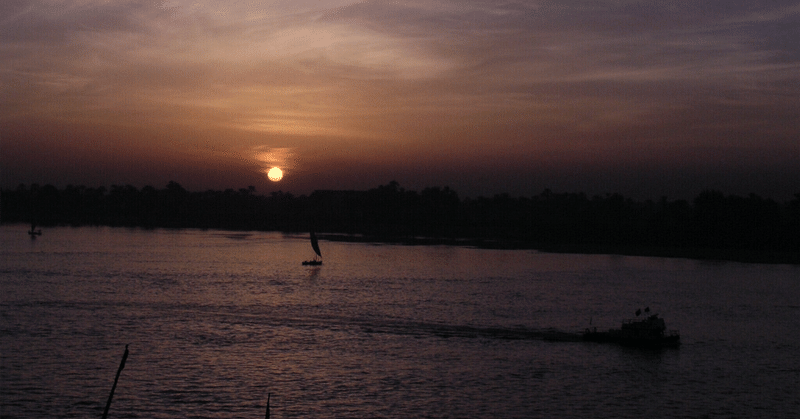
ナイル川についての英語長文 英検2級 オリジナル問題
この英語長文は英検2級程度です。
The Nile River
The Nile River, stretching over 6,650 kilometers, is not only the longest river in Africa but also a vital source of sustenance for the nations along its banks. For centuries, it has played a critical role in the development of civilizations, providing water, food, and transportation. Its annual flooding deposits rich silt along the riverbanks, creating fertile land for agriculture, which has been the backbone of the region's economy. Additionally, the river is a major source of hydroelectric power, contributing significantly to energy production in countries like Egypt and Sudan.
However, managing the Nile's resources has its challenges. The construction of dams, while beneficial for controlling floods and generating electricity, has also led to environmental concerns. These include the displacement of communities and alterations to the ecosystem, affecting the natural habitat of numerous species. Moreover, the competition for water among the Nile Basin countries has sometimes led to tensions, as the river's water is crucial for their agricultural and energy needs. The delicate balance between development and sustainability is a constant concern.
The future of the Nile River hinges on cooperation and sustainable management. Initiatives are underway to promote collaborative efforts among the Nile Basin countries to address water sharing and environmental preservation. For example, the Nile Basin Initiative aims to enhance cooperation and share the benefits of the river's resources equitably. Through such collaborations, it is hoped that the Nile can continue to be a source of life and prosperity for the region, while also protecting its environmental heritage.
Questions
What is one of the primary reasons the Nile River is considered vital for the regions along its banks?
A) Its role in international trade
B) Its ability to generate hydroelectric power
C) The fertile land created by its annual flooding
D) The tourism it attracts
What is a major challenge in managing the Nile's resources?
A) The development of urban areas along the river
B) Environmental concerns arising from dam construction
C) Lack of fish in the river
D) The river's length making it hard to navigate
Which initiative aims to promote cooperation among Nile Basin countries?
A) The African Union's Water Resource Strategy
B) The Nile River Project
C) The Nile Basin Initiative
D) The Sustainable Nile Development Program
Answers
回答: C) The fertile land created by its annual flooding
解説: The annual flooding of the Nile River deposits rich silt along the riverbanks, making the land fertile and ideal for agriculture, which is a critical aspect of the region's economy.回答: B) Environmental concerns arising from dam construction
解説: While dams provide benefits such as flood control and electricity generation, they also raise environmental issues, including habitat alteration and community displacement.回答: C) The Nile Basin Initiative
解説: The Nile Basin Initiative is a regional effort aimed at promoting cooperation and equitable resource sharing among the countries through which the Nile flows, addressing both water sharing and environmental protection.
日本語訳
ナイル川
6,650キロメートル以上にわたって流れるナイル川は、アフリカで最も長い川であるだけでなく、その岸辺に位置する国々にとって欠かせない生命線でもあります。何世紀にもわたり、文明の発展において中心的な役割を果たしてきたこの川は、水、食料、そして交通の手段を提供してきました。毎年の洪水は、川岸に肥沃な土を堆積させ、農業に適した土地を作り出してきました。この農業は、この地域の経済の基盤を形成しています。さらに、この川は、エジプトやスーダンのような国々におけるエネルギー生産に大きく寄与する、水力発電の主要な源泉です。
しかし、ナイルの資源を管理することは課題を伴います。ダムの建設は、洪水を制御し電気を発生させる上で有益ですが、地域社会の移転や生態系への変化を含む環境上の懸念をもたらしました。これにより、多くの種の自然な生息地が影響を受けています。さらに、ナイル流域国家間の水の競争は時に緊張を引き起こすことがあります。なぜなら、川の水は彼らの農業やエネルギーのニーズにとって不可欠だからです。開発と持続可能性の間の微妙なバランスは、常に懸念事項です。
ナイル川の未来は、協力と持続可能な管理にかかっています。ナイル流域の国々間での協力促進と環境保全への取り組みを目指したイニシアティブが進行中です。例えば、ナイル流域イニシアティブは、川の資源を公平に共有し、協力を強化することを目指しています。このような協力を通じて、ナイルが地域にとって生命と繁栄の源であり続けること、そしてその環境遺産を守ることが望まれています。
この記事が気に入ったらサポートをしてみませんか?
